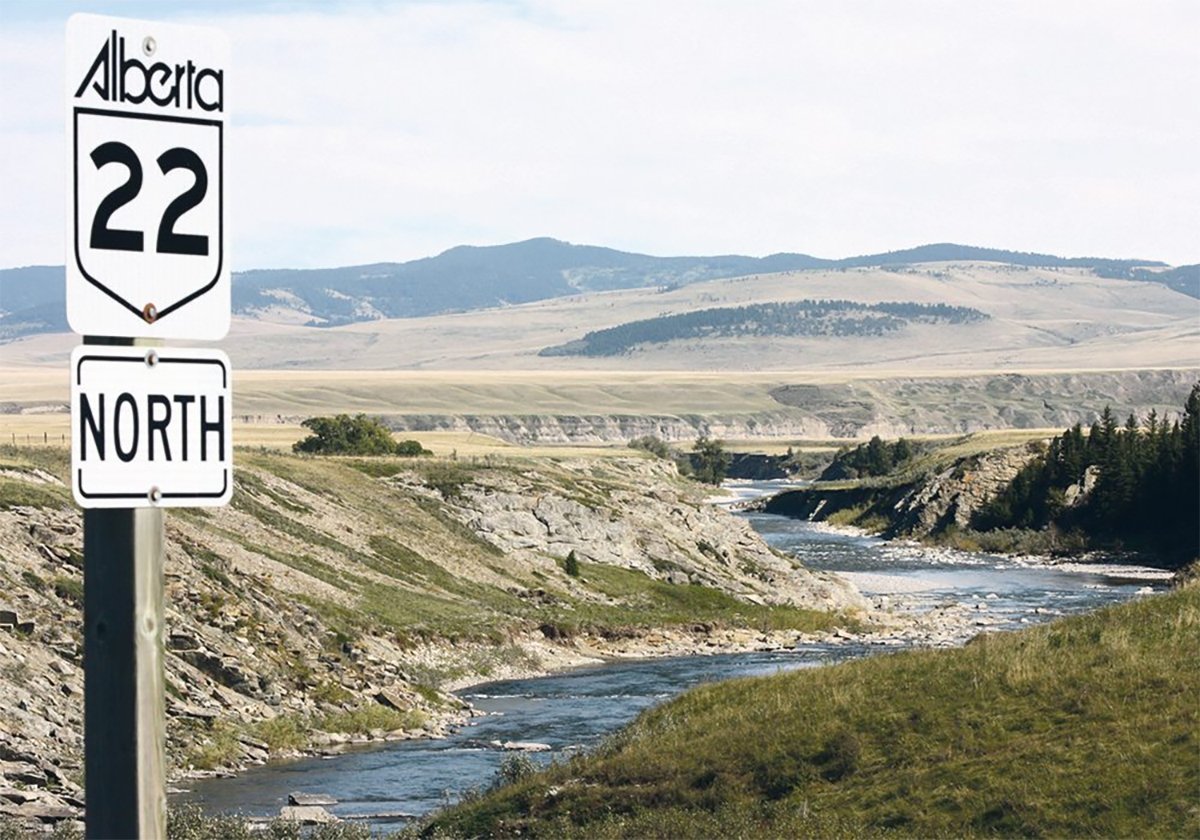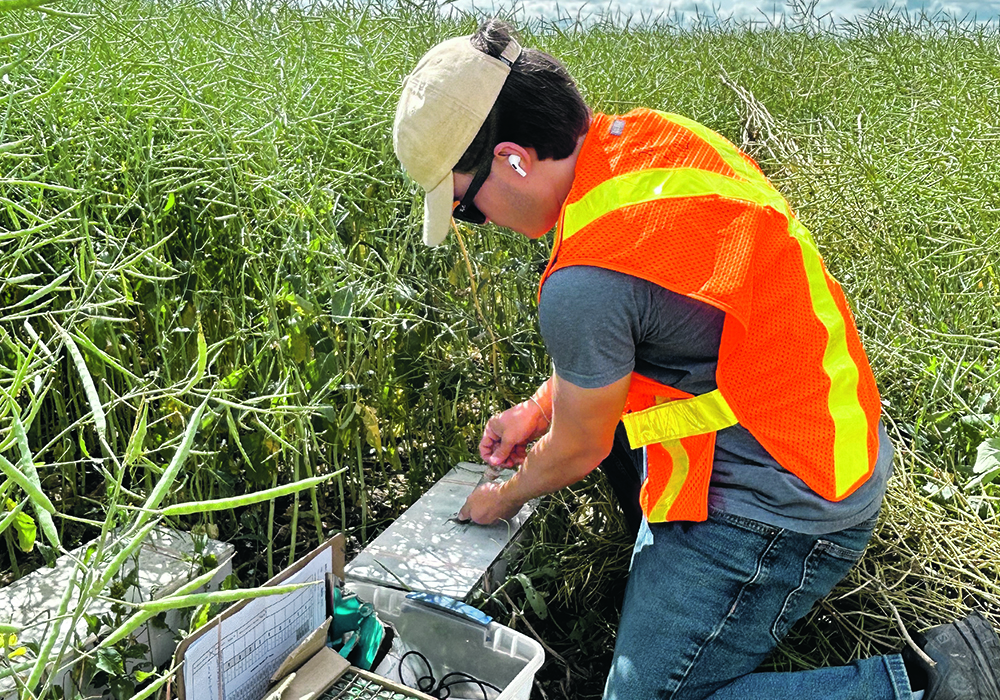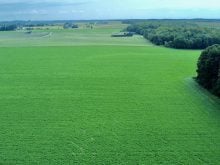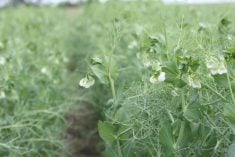WINNIPEG — Last year at harvest time, farmers across western Manitoba and parts of eastern Saskatchewan had a similar reaction.
When they looked at yield monitors in their combines, they were surprised at figures of 60 to 75 bushels an acre for spring wheat, despite lack of sufficient moisture during the growing season.
Other stories in this Special Report:
- Research dilemma: crops or climate?
- Ottawa’s approach to ag research called ‘narrow-minded’
- Emissions focus worries ag sector
- New focus called gov’t blind spot
- More clarity urged for ag research requests
“Spring wheat mostly did well across the region,” said a Manitoba Agriculture crop report from October on the northwest region. “Average estimated yield was 60 to 70 bu. per acre.”
Read Also

New coal mine proposal met with old concerns
A smaller version of the previously rejected Grassy Mountain coal mine project in Crowsnest Pass is back on the table, and the Livingstone Landowners Group continues to voice concerns about the environmental risks.
Growers in west-central Saskatchewan weren’t as fortunate. The average spring wheat yield in that region was 33 bu. per acre. Even that number isn’t horrible, considering the severe and prolonged drought in the western half of the province.
The town of Kindersley received only 100 millimetres of precipitation from April 1 to the end of August. Normally it would receive 220 mm during those five months.
The strong wheat yields in the eastern Prairies and at least some yield in western Saskatchewan suggest that crop genetics are helping farmers cope with climate extremes.
“It’s very real. When we turned into the dry cycle in 2019-20 and since … people were shocked with the yields they were getting (from) the new (genetic) material,” said Todd Hyra, western business manager for Secan, a non-profit that is the largest supplier of certified seed to Canadian farmers.
Given the recent performance of crop genetics, Hyra said he can’t comprehend the federal government’s latest priorities for agricultural research.
Policy makers in Ottawa are directing more money toward science “that addresses climate change and environmental sustainability,” says an Agriculture Canada document on its AgriScience Program.
As a result, fewer dollars are flowing toward plant breeding and varietal development.
“Absolutely, there is frustration. And a little bit of confusion,” Hyra said in March.
“From our (Secan) point of view, plant breeding and varietal development is the solution…. It shouldn’t be considered at odds to fighting climate change (or achieving) sustainability.”
The feds’ scientific focus on climate change is part of the Sustainable Canadian Agricultural Partnership (SCAP), a five-year funding agreement between the provinces and Ottawa.
A document explaining the AgriScience program says that research activities must “align” with at least one of three priorities:
- Climate change and environment.
- Economic growth and development.
- Sector resilience and societal challenge.
The document also says variety development is still a priority, but mostly for early-stage research.
“Later stage work continues to be eligible but will be of lower priority. Later stage work is typically characterized by the incremental development of traits, such as the delivery of finished varieties.”
Ottawa’s new priorities for agriculture, with a laser focus on climate change, is a significant departure from the past. Historically, research has focused on improving productivity.
Rob Graf is a retired winter wheat breeder who worked for Agriculture Canada in Lethbridge for about 24 years. He noticed the shift in priorities near the end of his career.
Folks in Ottawa seemed to lose interest in traditional agricultural research.
“There (seemed) to be this approach — if we’ve been doing something for a long time (then) maybe we need to shift resources somewhere else.”
The “somewhere else” or something new might be research on a legume cover crop that could provide nitrogen to the soil and possibly make crop production more sustainable.
New research on greenhouse gas emissions and the environment could become beneficial for agriculture, but intercropping peas and oats may only make sense for a small number of farmers.
In comparison, growers can easily adopt the latest variety of spring wheat. Maybe that variety has improved nitrogen use efficiency. Farmers simply buy the seed and plant it.
“You can work on research, but to try and put it into a deliverable package that … farmers can use, (it’s) a breeding program that does that,” Hyra said.
“It takes something from theory … to deliverable that can be used on a farm.”
To be clear, the feds still fund plant breeding research for wheat and many other crops.
Agriculture Canada announced in March that it is providing $11.2 million to the Canadian Wheat Research Coalition, which will “accelerate breeding and increase wheat production resilience in response to evolving threats like pests and diseases associated with climate change.”
The funding is delivered through the Agri-Science Program, which means a percentage of research dollars must be spent on greenhouse gas emissions research involving wheat and less can be spent on varietal development.
“There is only so much money available … (For) a breeding program to be effective and competitive and advance agriculture, (it) needs to have a critical mass,” Hyra said.
“As you chip away at that (funding), the program becomes less competitive and less likely to find that next (blockbuster variety).”
In an email, Agriculture Canada said it continues to make “significant investments” in varietal development.
“(Agriculture Canada) recognizes that climate resilient varieties are an essential tool to address climate change and support environmental sustainability…. Through the implementation of the AAFC Strategic Plan for Science, the department highlights the importance of supporting genetics and trait development to address climate challenges,” the department said.
“Variety development activities represent a significant investment, with outcomes that will touch on all three priority areas (climate, economic growth and sector resilience)…. While the AgriScience Program provides a policy framework to consider research activities, industry continues to have the flexibility to choose what work it wishes to pursue within the priority areas.”
About six years ago, Agriculture Canada tried to change the royalty system in the seed industry.
The department and the Canadian Food Inspection Agency held consultations with farmers and industry groups about value creation in the seed sector.
At the heart of the discussion was “whether Canadian farmers should be expected to pay trailing or back-end royalties on the use of farm-saved seed” so plant breeders receive a reasonable return on their investments, The Western Producer reported in 2019.
Farm groups rejected the concept and no changes were made to the royalty system. As a result, some crop breeding companies abandoned the Canadian market.
If there were private breeders, government could get out of the way and focus on basic research, Graf said.
“We’re nowhere near that type of scenario in most crops. We are (there) in canola and that is working. But certainly not in wheat.”
Until Canada has the proper financial incentives, “we’re going to be in a holding pattern in terms of private industry coming in,” Graf added.
So, the responsibility for developing wheat, barley and other crops falls onto public plant breeders with Agriculture Canada or at universities. Those scientists are world class and they can produce excellent varieties.
But if funds are directed at non-ag priorities, like cutting greenhouse gas emissions, Canada may struggle to keep up with global competitors.
“If money is taken out of field-ready cultivar development, what happens is we start lagging behind the rest of the world and our farmers become less competitive,” Graf said.
“Part of sustainability is also the ability of farmers to … make some money. (That) used to be talked about a lot more.”


















